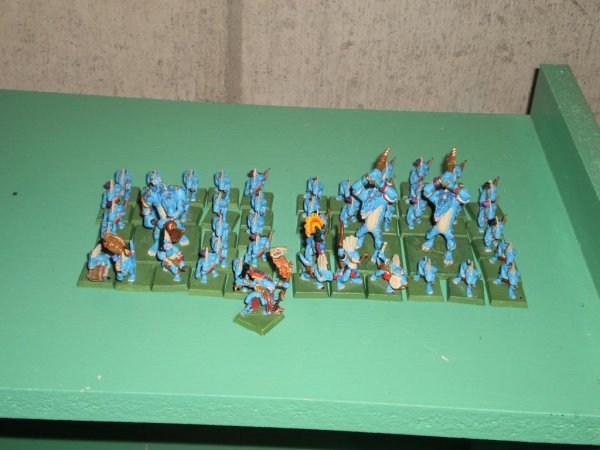Skinks
Praise be the Old Ones and all that they make Praise be the Skinks, Third spawning of the First Tasks too small for Slann the Skinks undertake The First’s vital tasks between Skinks disbursed What Saurus cannot destroy, skinks shall waylay When Saurus rage grows too strong, Skinks restrain Through cunning and poison, foes they shall slay Outside of war, the cities they maintain From many spawnings the Skinks are amassed Workers, warriors, masters of the beast Each Skink spawned with his own preordained caste All serve the Great Plan both greatest and least Their vital tasks are many and varied Upon their backs, other First carried -Excerpt from Song of the Old OnesSkinks are a subspecies of the Lizardmen or First Children of the Old Ones as they prefer to call themselves. Skinks make up the overwhelming majority of the overall population of the Skinks. Skinks perform almost all of the Lizardmen's skilled labor and many of their unskilled labor jobs. Skinks are the scribes, porters, craftsmen, scouts, farmers, hunters, and more of Lizardmen society. While the backbone of the First's military efforts rest on the shoulders of the Saurus warriors, the First would never succeed in battle without the support roles given by the skinks. Because skinks are the most human of all the First, (especially the way I write them) most of my POV characters in fiction are Skinks.
Basic Information
Anatomy
On average, skinks are almost as tall as humans but they are a lot skinnier with less overall mass. Most have a crest on top of their head that can be risen or lowered to express emotions or other nonverbal communication.
Skinks are bipedal with lizard like tails that are usually kept off of the ground. The tails are mainly for balance. Skinks can manipulate objects with their tails but their tails are not especially strong. Unlike Sauri and Kroxigor, Skinks cannot properly weaponize their tails but they can still slap people with thier tails as a sign of disrespect.
They vaguely resemble ordinary newts or skinks. "Skink" is a label given to them by humans. I'm sure they call themselves something different but i leave it unchanged for ease of readers' understanding. Skaven tend to call Skinks "Crest Newts".
Skink leaders are usually about a foot taller and broader, with much larger crests, slightly bigger heads, and more muscle tone.
Genetics and Reproduction
Skinks reproduce asexually like most of the First.
Skinks will periodically emerge either singular or in groups from sacred spawning pools. Unless Saurus spawning pools, skink spawning pools are always above ground and open to the sky.
Usually skinks emerge in groups, but when a skink emerges singularly, that Skink is said to be destined for greatness and is immediately groomed to be a priest or chief.
Growth Rate & Stages
Skinks emerge from their spawning pools in adult bodies, born with a basic vocabulary and advanced instincts. They also are born with an instinctual deference to the Slann and the Old Ones.
Skinks have be taught greater language skills, how to read, how to fight, and how to use tools. Skinks are fast learners in general. Within the first few years after emerging from their spawning pools, their learning ability is extremely accelerated. If humans could witness it, they would blown away by how a Skink can learn in one year what would take a young human a decade or more to master
Skinks are born with adult bodies. Typical skinks have a maximum life span of about eighty years under optimal circumstances (though few die of old age in Lustria). Skinks don't show much visible signs of aging till roughly their fiftieth year and they rarely show noticeable signs of impaired physical abilities until well into their sixth decade.
Skink chiefs and priests can live over 150 years, but again these individuals rarely die of Old Age. A very rare few powerful Skink priests live to very old ages, something even up to 1000 years. Most believe their extended lifespan is due to the magical interference of the Slann some view this as a blessing of the Old Ones themselves.
Dietary Needs and Habits
Skinks are true omnivores capable of eating a wide variety of things. Skink tastes vary individually much like with humans and many have different favorite food.
Skinks like meat when they can get it, but most large cuts of meat are reserved for Sauri and Kroxigor. Most skinks get most of their protein from insects and other small invertibrates, fat grubs are favored because they are meaty, don't have indigestible shells and are easy to catch.
Skinks can eat a wide variety of plants. Lustria has many inedible and poisonous but most Skinks' early education helps them tell the tasty plants from the dangerous ones. Some skinks prefer fruit, others root vegetables. Most skinks are not picky eaters and will not turn their nose up on most food when hungry enough.
Additional Information
Perception and Sensory Capabilities
A few Skinks have truly exceptional eye sight, but most Skinks have visual senses roughly on par with humans.
When you get down to brass tacks, skinks have a slightly wider field of vision compared to humans and similar visual range, but humans are slightly better at discerning details on objects that are close.
Their hearing is a little bit above human norms and their smell is by far superior to humans.
Civilization and Culture
Naming Traditions
Most names are at least loosely based on direct translations of the Saurian language. Most skink names are two syllables though higher ranking Skinks, especially priests, are likely to have longer names.
Genetic Ancestor(s)
Genetic Descendants
Lifespan
75 years
Average Height
five and a half feet
Average Weight
100 pounds
Average Length
six and a half feet nose to tail.
Geographic Distribution
Related Ethnicities



Comments